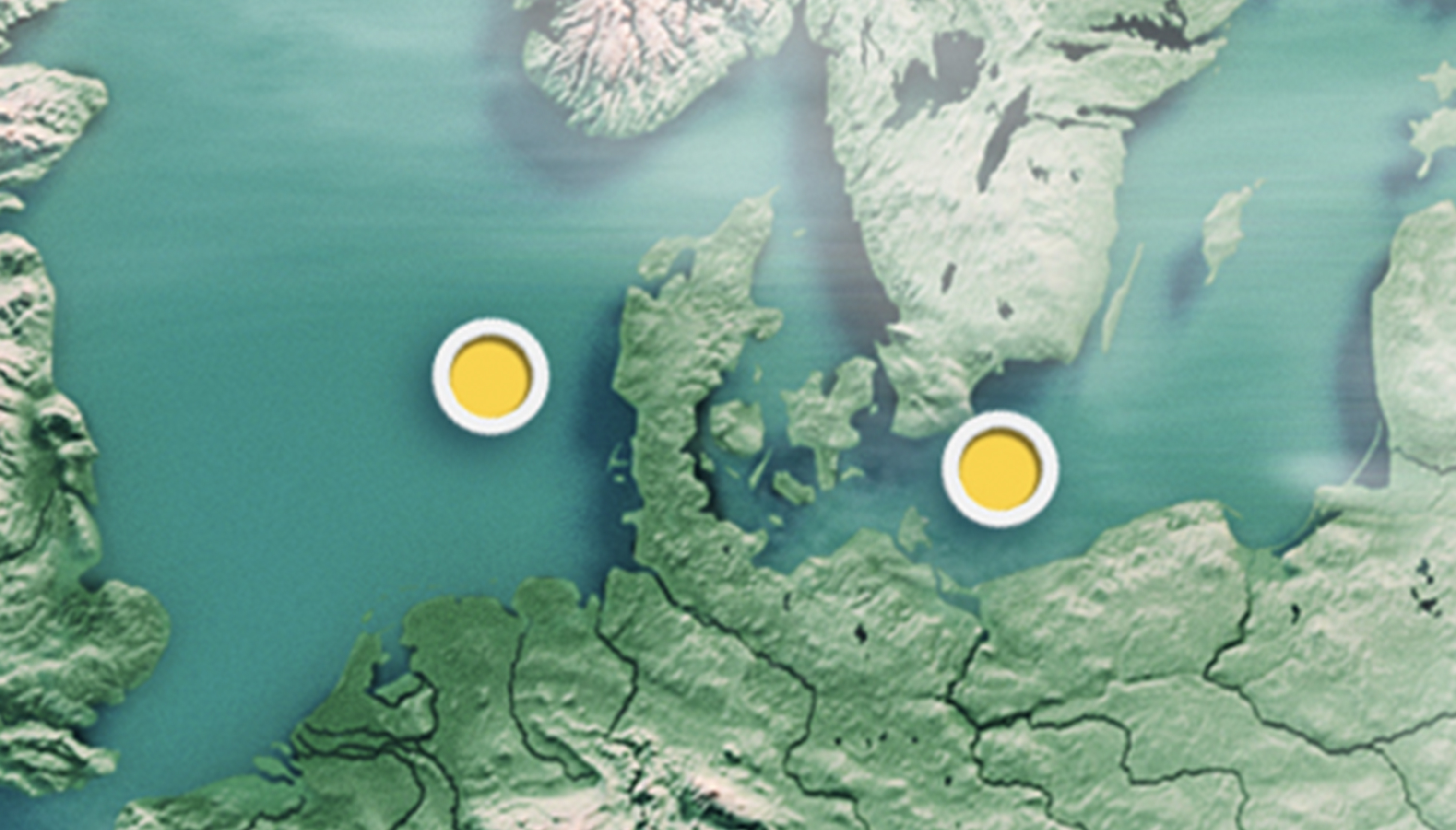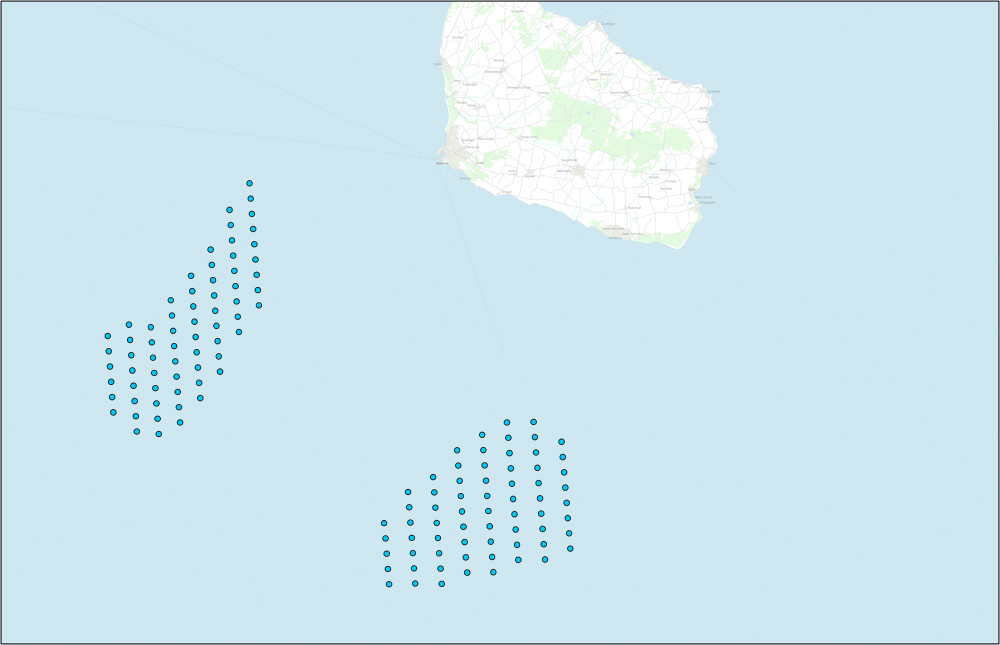
Preliminary studies for the world’s first energy islands begin
The Danish Minister for Climate, Energy and Utilities, Dan Jørgensen, has now ordered Energinet to conduct preliminary studies for energy islands in the North Sea and Baltic Sea. Energinet will thereby lay the foundation for the energy islands – one of the largest construction projects in Denmark’s history. Offshore wind power from the energy islands will supply green electricity to Europe and for the production of hydrogen and green fuels for planes, ships and industrial processes.
How do energy islands harmonise with the land and sea environments and organisms? What are the wind and sea current patterns, and how big are the waves? Where should the power be brought ashore on the west coast of Jutland and on Bornholm? How will fishing be impacted, and where can land be reserved for Power-to-X plants?
The Danish Minister for Climate, Energy and Utilities, Dan Jørgensen, has now asked Energinet to commence preliminary studies for the coming energy islands. The preliminary studies have to answer a number of important questions about the environment and physical conditions in connection with the energy islands, the associated future offshore wind farms, and the land-based installations to bring the offshore wind power ashore and distribute it to energy consumers.
-The preliminary study will be a huge project. At sea alone, Energinet has to investigate areas roughly three times the size of Bornholm. Wind farms, cables and installations for the Energy islands will cross shipping routes, fishing areas, already planned offshore wind farm areas, World War I and II minefields and much more,” says Vice President Hanne Storm Edlefsen, who is heading up Energinet’s work on the energy islands.
On land, Energinet has to plan the infrastructure to connect the energy islands to the onshore energy system on Bornholm, Zealand and in the municipalities of west Jutland. The energy island in the Baltic Sea has to supply 2 GW once it has been completed, while the energy island in the North Sea has to initially supply 3 GW, rising to 10 GW during the 2030s. The expected final capacity of the two energy islands of 12 GW is equal to the offshore wind capacity currently installed in the entire EU region.
The North Sea: Target area for preliminary studies with example locations for the energy island and associated offshore wind power. The offshore wind farms will be located at least 60 km from Thorsminde.
The Baltic Sea: Locations for 2 GW of offshore wind power near the Island of Bornholm. The wind turbines will be placed 20 km from the coast south of Rønne, Bornholm.
Click on the maps to see bigger picture.
New era of offshore wind power
The first offshore wind farm in the world was built in Denmark in 1991. Almost 30 years later, Denmark is again writing world history as it lays the foundation for the world’s first energy islands.
-The energy islands mark a new era for large-scale offshore wind power. The vast wind resources in the North Sea and Baltic Sea will be harnessed to contribute to the green transition in Europe, and to create climate-neutral fuels for planes, ships and industry. Energinet is ready, and we are proud to make our contribution to the complex task of laying the foundation for the world’s first energy islands,” says Hanne Storm Edlefsen, Vice President at Energinet.
The energy islands will lie so far out to sea, that power from the wind farms will have to be converted to direct current on each island before being transmitted through cables to several neighbouring countries. Energy islands are thus a logical next step, given that offshore wind power generation in Europe has to be multiplied during the coming 10, 20 and 30 years.
On 19 November 2020, the European Commission published its strategy for the expansion of offshore renewable energy production. The target is 60 GW of offshore wind power in 2030, rising to 300 GW in 2050. The current capacity in the EU region is 12 GW of offshore wind power.
Ambitious timetable
Climate change, and the ambitious goals of reducing climate gas emissions, mean that the timetable for Energinet’s preliminary studies for construction of the world’s first energy islands also have to be ambitious. The studies that can be initiated, based on existing knowledge about the location and types of plant, must also be initiated as soon as possible.
-Ships must be dispatched to investigate the seabed, and we must investigate how the plants can be built with maximum consideration for humans, organisms and the environment. We are entering a busy phase, where we must consult with the parties that will perform the complicated studies, as well as the affected parties, such as the municipalities in which the land-based facilities will be installed,” says Poul-Jacob Vilhelmsen, Project Manager for Energinet’s work in connection with the energy islands in the North Sea and Baltic Sea.
The preliminary studies must be completed by H1 2024, so that potential tenderers can submit their bids for construction of the elements that will make up the energy islands.
More details of the preliminary studies
The Danish Energy Agency is the authority that issues permits to Energinet to launch specific studies, pursuant to the Danish environmental legislation, etc.
The preliminary study project will be the largest Energinet has undertaken to date. An enormous area of the sea has to be investigated, and a number of studies must be performed in connection with land-based facilities on Bornholm, Zealand and in the municipalities of west Jutland.
The preliminary studies will generally consist of the following elements:
- Strategic environmental assessment based on the plan for the two energy islands provided by the Danish Energy Agency. The strategic environmental assessment covers an assessment of the environmental impacts of the plan at sea and on land, impact assessment for Natura 2000 areas, and visibility analyses if offshore wind farms will be visible from land.
- Geotechnical and geophysical investigations of the seabed in connection with the energy islands, offshore wind farms and cable connections, including international connections. The studies must identify the geological conditions for foundation of the energy islands, and locate any unexploded bombs on the seabed, etc.
- On land, Energinet must provide directions on the location for connecting the offshore power and constructing plant. Energinet must prepare a basic plan for the technical installations and consult with relevant municipalities on reserving land for future Power-to-X or battery plants.
- Supplementary studies of the marine environment, in addition to the requirements set for the strategic environmental assessment. These studies include consideration for birds, marine mammals, fish, fishing and navigational safety. They also cover seabed archaeology, including the area in the North Sea where the Battle of Jutland took place 1916.
- Energinet must mature and develop international connections in cooperation with the TSOS in the countries agreements are concluded with.




